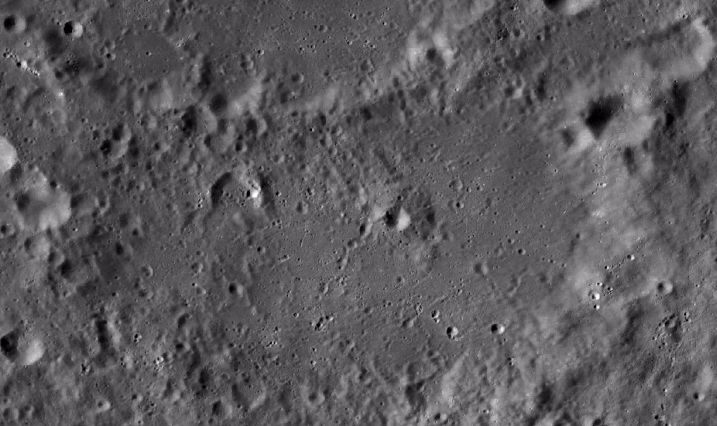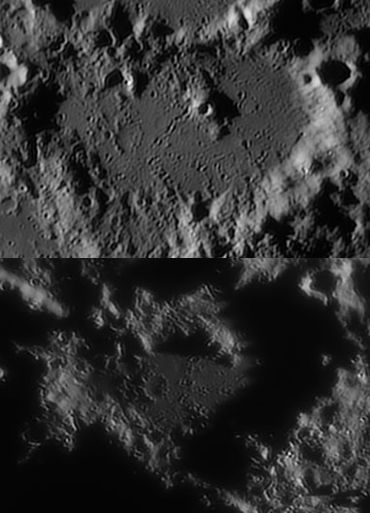Difference between revisions of "Regiomontanus"
| (3 intermediate revisions by the same user not shown) | |||
| Line 3: | Line 3: | ||
{| class="wiki_table" | {| class="wiki_table" | ||
| | | | ||
| − | Lat: 28.28°S, Long: 1.09°W, Diam: 126.64 km, Depth: 3.61 km, [ | + | Lat: 28.28°S, Long: 1.09°W, Diam: 126.64 km, Depth: 3.61 km, [[R%C3%BCkl%2055|Rükl: 55]], pre-Nectarian<br /> |
|} | |} | ||
<div id="toc"> | <div id="toc"> | ||
| − | + | [[Image:Regiomontanus.jpg|Regiomontanus.jpg]]<br /> LRO<br /> | |
| − | |||
=[[Image:Regiomontanus%20in%20the%20evening%20and%20morning.jpg|Regiomontanus in the evening and morning.jpg]]= | =[[Image:Regiomontanus%20in%20the%20evening%20and%20morning.jpg|Regiomontanus in the evening and morning.jpg]]= | ||
Evening and morning in Regiomontanus by Peter Oberč, Slovenia<br /> | Evening and morning in Regiomontanus by Peter Oberč, Slovenia<br /> | ||
| Line 13: | Line 12: | ||
[http://www.lpod.org/coppermine/thumbnails.php?album=search&type=full&search=Regiomontanus LPOD Photo Gallery] [http://www.lpi.usra.edu/resources/lunar_orbiter/bin/srch_nam.shtml?Regiomontanus%7C0 Lunar Orbiter Images] [http://www.lpi.usra.edu/resources/apollo/search/feature/?feature=Regiomontanus Apollo Images]<br /> <br /> | [http://www.lpod.org/coppermine/thumbnails.php?album=search&type=full&search=Regiomontanus LPOD Photo Gallery] [http://www.lpi.usra.edu/resources/lunar_orbiter/bin/srch_nam.shtml?Regiomontanus%7C0 Lunar Orbiter Images] [http://www.lpi.usra.edu/resources/apollo/search/feature/?feature=Regiomontanus Apollo Images]<br /> <br /> | ||
==Maps== | ==Maps== | ||
| − | ''([ | + | ''([[LAC%20zone|LAC zone]] 95D3)'' [http://www.lpi.usra.edu/resources/mapcatalog/LAC/lac95/ LAC map] [http://www.lpi.usra.edu/resources/mapcatalog/usgs/I822/ Geologic map]<br /> <br /> |
==Description== | ==Description== | ||
<br /> | <br /> | ||
==Description: Elger== | ==Description: Elger== | ||
| − | ''([ | + | ''([[IAU%20directions|IAU Directions]])'' REGIOMONTANUS.--A still more irregular walled-plain, of about the same area, closely associated with the S. flank of [[Purbach|Purbach]], having a rampart of a similar complex type, traversed by passes, longitudinal valleys, and other depressions. Schmidt alone shows the especially fine example of a crater-row, which is not a difficult object, in connection with the S.W. wall. Excepting one crater, nearly central, and some inconspicuous ridges, I have seen no detail on the floor. Schmidt, however, records many features.<br /> <br /> |
==Description: Wikipedia== | ==Description: Wikipedia== | ||
[http://en.wikipedia.org/wiki/Regiomontanus_(crater) Regiomontanus]<br /> <br /> | [http://en.wikipedia.org/wiki/Regiomontanus_(crater) Regiomontanus]<br /> <br /> | ||
==Additional Information== | ==Additional Information== | ||
| − | Depth data from [ | + | Depth data from [[Kurt%20Fisher%20Crater%20Depths|Kurt Fisher database]]<br /> |
* Westfall, 2000: 3.61 km | * Westfall, 2000: 3.61 km | ||
* Cherrington, 1969: 2.95 km | * Cherrington, 1969: 2.95 km | ||
* Central peak height | * Central peak height | ||
| − | ** [ | + | ** [[Sekiguchi%2C%201972|Sekiguchi, 1972]]: 1.2 km <span class="membersnap">- fatastronomer</span> |
| − | * Central peak has a summit crater 5.5 km in diameter--[ | + | * Central peak has a summit crater 5.5 km in diameter--[[Sekiguchi%2C%201972|Sekiguchi, 1972]]<span class="membersnap">- fatastronomer</span> |
==Nomenclature== | ==Nomenclature== | ||
Johannes Müller von Königsberg (June 6, 1436 – July 6, 1476), known by his Latin pseudonym [http://en.wikipedia.org/wiki/Regiomontanus Regiomontanus], was an important German mathematician, astronomer and astrologer.<br /> <br /> | Johannes Müller von Königsberg (June 6, 1436 – July 6, 1476), known by his Latin pseudonym [http://en.wikipedia.org/wiki/Regiomontanus Regiomontanus], was an important German mathematician, astronomer and astrologer.<br /> <br /> | ||
| Line 33: | Line 32: | ||
[http://www2.lpod.org/wiki/August_30,_2004 Are Central Peaks Volcanoes]<br /> [http://www2.lpod.org/wiki/February_6,_2007 Like Getting New Glasses]<br /> <br /> | [http://www2.lpod.org/wiki/August_30,_2004 Are Central Peaks Volcanoes]<br /> [http://www2.lpod.org/wiki/February_6,_2007 Like Getting New Glasses]<br /> <br /> | ||
==Lunar 100== | ==Lunar 100== | ||
| − | [ | + | [[Lunar%20100|L46]]: Possible volcanic peak.<br /> <br /> |
==Bibliography== | ==Bibliography== | ||
Wood, C.A. 7/2006. False Volcanoes on the Moon. S&T 112:(1):66-67<br /> <br /> <br /> | Wood, C.A. 7/2006. False Volcanoes on the Moon. S&T 112:(1):66-67<br /> <br /> <br /> | ||
---- | ---- | ||
| − | + | </div> | |
Latest revision as of 20:30, 16 April 2018
Contents
Regiomontanus
|
Lat: 28.28°S, Long: 1.09°W, Diam: 126.64 km, Depth: 3.61 km, Rükl: 55, pre-Nectarian |
Evening and morning in Regiomontanus by Peter Oberč, Slovenia
Images
LPOD Photo Gallery Lunar Orbiter Images Apollo Images
Maps
(LAC zone 95D3) LAC map Geologic map
Description
Description: Elger
(IAU Directions) REGIOMONTANUS.--A still more irregular walled-plain, of about the same area, closely associated with the S. flank of Purbach, having a rampart of a similar complex type, traversed by passes, longitudinal valleys, and other depressions. Schmidt alone shows the especially fine example of a crater-row, which is not a difficult object, in connection with the S.W. wall. Excepting one crater, nearly central, and some inconspicuous ridges, I have seen no detail on the floor. Schmidt, however, records many features.
Description: Wikipedia
Additional Information
Depth data from Kurt Fisher database
- Westfall, 2000: 3.61 km
- Cherrington, 1969: 2.95 km
- Central peak height
- Sekiguchi, 1972: 1.2 km - fatastronomer
- Central peak has a summit crater 5.5 km in diameter--Sekiguchi, 1972- fatastronomer
Nomenclature
Johannes Müller von Königsberg (June 6, 1436 – July 6, 1476), known by his Latin pseudonym Regiomontanus, was an important German mathematician, astronomer and astrologer.
LPOD Articles
Are Central Peaks Volcanoes
Like Getting New Glasses
Lunar 100
L46: Possible volcanic peak.
Bibliography
Wood, C.A. 7/2006. False Volcanoes on the Moon. S&T 112:(1):66-67

